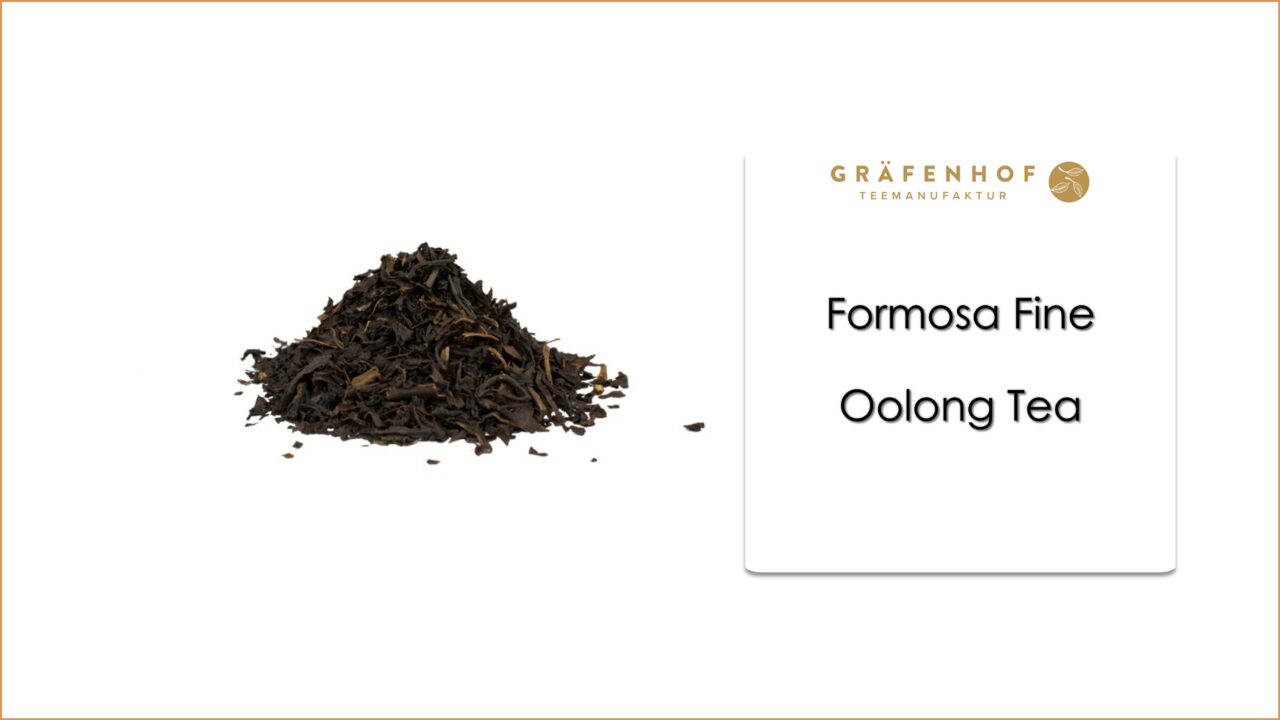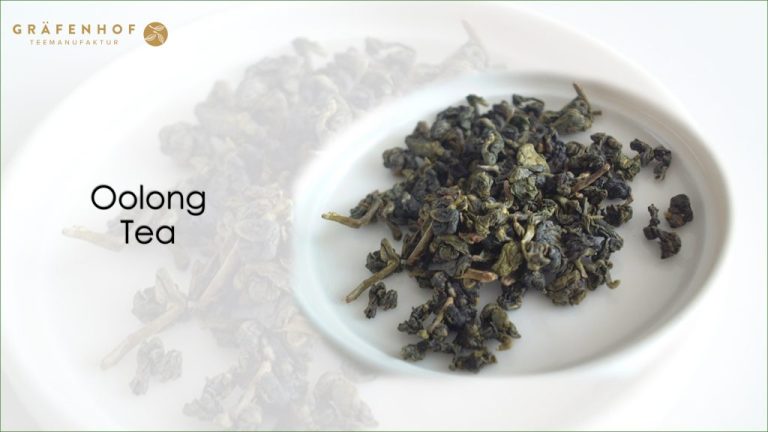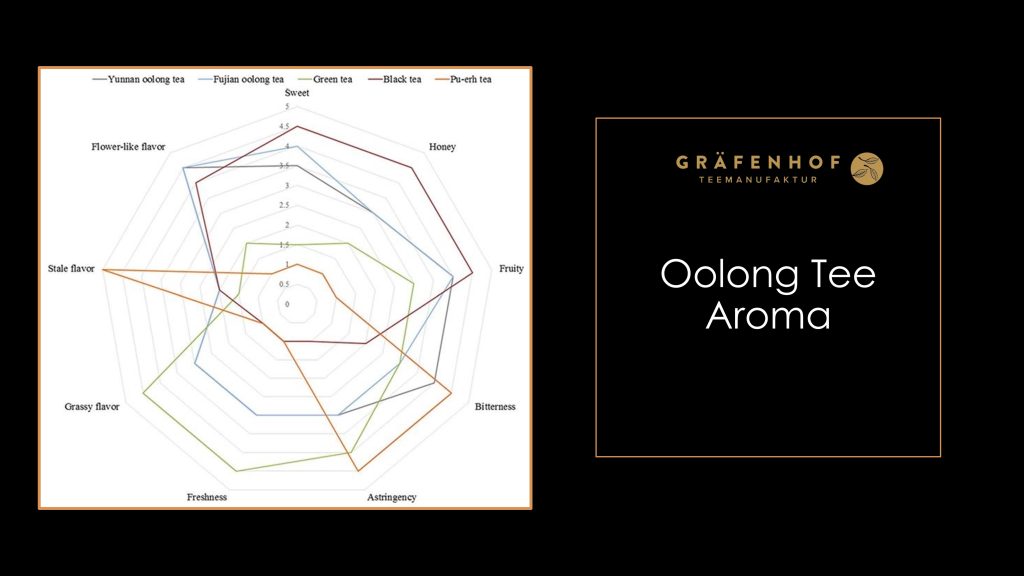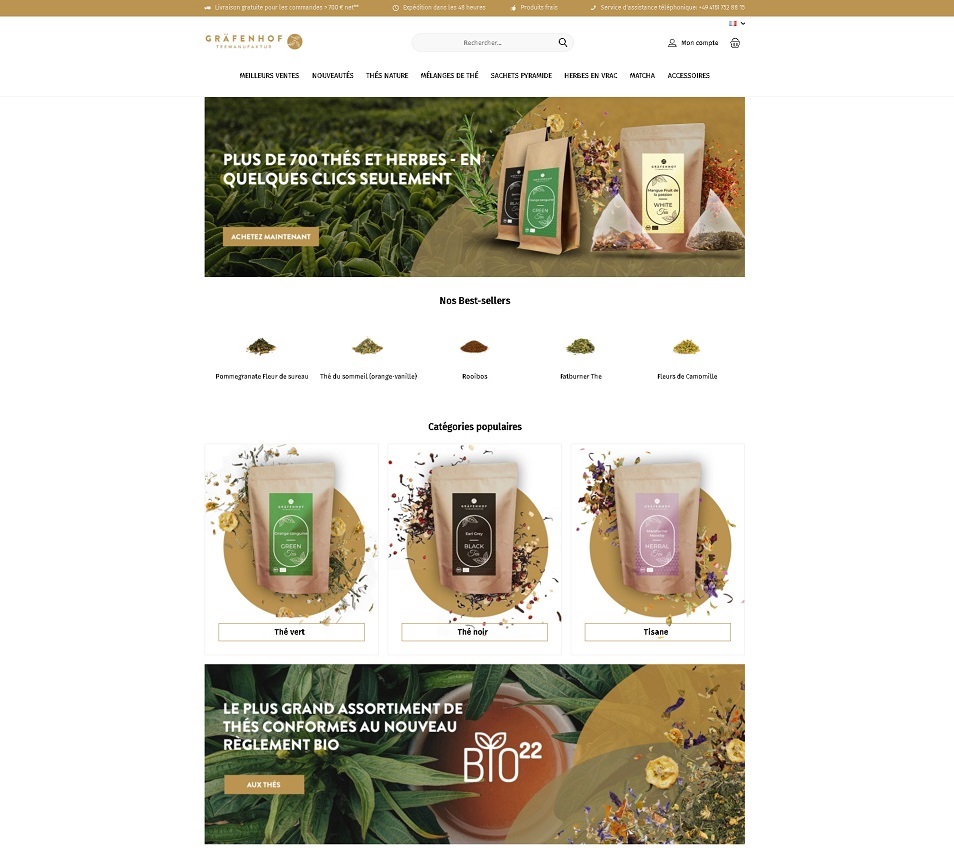TEA KNOWLEDGE
Oolong Tea: The Artisan Tea
WHAT IS OOLONG TEA?
Oolong tea is a mild oxidized – semi-oxidized – tea that is also known as wulong tea or black dragon tea. In fact Oolong is not only another tea, but a category of teas.
Once a type of tea only know among Tea Connoisseurs, Oolong teas have grown in popularity in the past decade due to their wide range of rich and complex aromatic profiles.
Oolongs are best savored when they are made slowly, over several infusions, in a gōngfū or “kung-fu tea” style ceremony in traditional porcelain containers, such as Gaiwan porcelain.
This style emphasizes the attention needed to prepare Oolong tea properly. This is one of the reasons why Oolong teas are some of the most handcrafted teas in the world.
Oolong is one of the 4 true tea types deriving from the Camellia Sinensis plant.
As with green tea, black tea, white tea, and several other specialized types of tea, oolong consists of varieties and cultivars from the Camellia sinensis plant, originally from China. What separates oolong tea from other tea varieties is the level of oxidation.
Oolong is neither black tea nor green tea.

Oxidation
The level of oxidation is what defines the characteristics of green, oolong, and black teas. Green tea is not oxidized and black tea is fully oxidized.
Oolong teas are semi-oxidized or partially oxidized, a determining factor when it comes to the wide range of flavors, variations, and complexities. They vary drastically in flavor depending on how long they are oxidized. The result depends on the production style of the tea maker.
In general, oolong teas undergo anywhere from 8 to 80 percent oxidation. Each tea master uniquely tailors the oxidation process, resulting in a world of flavor that makes oolong an extremely versatile tea.
- Lightly oxidized oolongs have green tea characteristics with fresh and grassy like taste and hints of flowers
- Heavily oxidized oolongs come closer to Black teas as they become darker in color, with richer floral notes and malt aroma.
The oxidation process turns each leaf from green and fresh to brown and rich. Black tea is heavily oxidized while green tea is lightly oxidized.
Oolong teas are half fermented as they are heated to start the oxidation process in teas similar to black teas, but the process is quickly halted so that the leaves do not fully oxidize.
This makes Oolong taste and feel like something between black tea and green tea, and have more black tea characteristics or more green tea characteristics, depending very much on the skills and the way a particular tea master takes while processing the tea.
What Semi Oxidized means?
The best way for us to visualize and understand oxidation, we should think about the browning process that occurs when apples or avocados are cut in half and are exposed to open air.
Tea starts to experience a similar transformation when it is picked. As with any other organic molecule, it starts to change rapidly when exposed to weather conditions
How Tea Masters Control tea Oxidation?
Oxidation begins when harvested tea leaves are exposed to oxygen and the chemical reaction causes the tea leaves to darken, or begin to break down.
The different levels of oxidation in tea are responsible for the different flavours and aromas that create the different types of tea we drink every day. Oxygen, heat, light and humidity are the factors that cause oxidation.
The greater the exposure to these four elements, the faster oxidation occurs.
Tea leaves begin to oxidise as soon as they are plucked, so to avoid total decomposition it is necessary to take steps to control the oxidation process. The best way to control the oxidation process and stop decay at any point is to subject tea leaves to high temperatures.
The Shape
Oolongs are traditionally rolled and molded alternately, resulting in more complex and nuanced flavors, more controlled oxidation, and intricate shapes.
The traditions of the tea master who prepares the tea and his artisanal rolling techniques will determine the Oolong shape.
The rolling plays a key role in oolong tea processing that defines the appearance, color, and aroma of the final tea leaves.
The tea master can subtly change the direction of the final flavor of the tea, depending on the shape and timing of the rolled leaves.
Common shapes for oolong teas are semi-ball or ball shaped and twisted. Ball and semi-ball oolongs can be consumed through a number of infusions, preferably in Yixing gongfu teapots.
Following oxidation and partial shaping, they are heated to stop oxidation and carefully shaped a final time. In addition to this basic heating procedure, many oolongs are also roasted.
Roasting gives the oolongs darker aromas and flavors reminiscent of ripe fruit (especially stone fruit), nuts, roasted beans, caramel, coffee, or chocolate.
The variety of oxidation, infusion, and roasting makes oolong tea a broad tea category with a wide variety of flavors and aromas ranging from fresh, clean, and herbal to black, roasted, fruity, and even espresso.
Because of their slight oxidation, baozhong or pouchong teas are considered by some to be in a separate category from green oolong teas.
Oolong: The Origins
There are a few theories and legends about the exact origins of oolong tea, however there is no doubt that it is of Chinese origin and most likely originated several centuries ago.
In China, “oolong” literally means black dragon tea, although it is sometimes spelled as “wulong”. This is due to one particular theory about the origin of this unique tea.
According to the story, a farmer named Wu Liang got distracted while plucking tea leaves, forgetting to dry them as he hunted a deer in the river. A day later, when he remembered to collect his tea, he noticed that the leaf’s color had changed and that, once cooked, the tea had a smoother, more aromatic flavor ( as it had partially oxidized overnight).
Over time, Wu Liang tea was called wu-long tea, and thus oolong tea was born.
Oolong Tea Provenance
Today, the vast majority of Oolong teas are produced in the Wuji Mountains and Anxi County regions of Fujian, China and on a smaller scale, in the Guangdong region.
The most famous production area is the high, rocky region of Wuji Mountain. Some of the most famous and expensive types of Oolong Tea originate from Wuji, including the Da Hong Pao Oolong. This tea is one of the most expensive teas in the world (More on that later)
This region primarily uses organic farming techniques, so for the most part, teas from this area are certified organic. Another prolific, but perhaps less well known, Oolong production area is the Anxi region.
However, some the highest quality and most recognized types of less oxidize, light green and light sweet flavored Oolong teas originate from the high-altitude regions on the island of Taiwan.

The Best Oolong Teas
Chinese Oolong Teas
Phoenix tea (Dan Chong or Dan Cong)
Phoenix oolong is a speciality of the Guangdong province in China and is one of the best selling teas in the world. Its Chinese name means “single bush”.
What makes the Phoenix oolong tea very unique in terms of taste and characteristics is that the leaves are harvested from a single bush of the tea plant. As Each bush has a different flavour, each tea bath will taste different.
The dried leaves have a curly appearance that unfolds slowly while steeping the tea.
Today, Phoenix tea is a denomination used when referring to oolong teas originating and produced from the Guangdong province, not just those from a single bush. Phoenix teas are known for their natural floral and fruit flavours and aromas.
The Phoenix oolong tea main characteristics is its rich yet mild and refreshing full-bodied flavour. Some Phoenix oolongs have a floral flavour at times similar to orange blossoms or mango like as well as orchids. Other Phoenix oolongs develop a fruity or spicy taste, with flavours very similar to ginger and grapefruit.
Iron Goddess of Mercy (Ti Kuan Yin or Tie Guan Yin)
This type of oolong tea is arguably the most famous Chinese tea.
Orinigally cultivated in the high mountain regions of Southern fujian province, the Iron Goddess of Mercy tea is harvested in the Anxi region.
This Oolong Chinese tea was originally slightly oxidized and very lighlty roasted. In recent times, its has adopted a new home, Taiwan. as slow growth, hand picking methods and repeating roasting produces a higher quality tea.
There is a lot of folklore and legend surrounding the Iron Goddess tea.
One of the most interesting legends has it that Budhist monks trained monkeys to harvest tea plant leaves in difficult to access high cliff edges. That is where the nickname “monkey-picked” comes from.
These unique oolong teas were reagrded as the highest quality teas and only used to brew tea for the emperors and the highest members of society of China . .
Today, these once unique high mountain oolong teas reserved for royalty only are mass produced; Iron Goddess of Mercy teas are available at most tea shops and in online stores.
Iron Goddess of Mercy teas is a light, refreshing and velvety tea , with golden color floral aroma with hints of honey. It’s pleasant smell is often compared to the smell of orchids.
Wuyi Oolong Tea (Da Hong Pao)
At the other end of the oolong spectrum is Red Robe tea.
Da Hong Pao oolongs stand at the very other extreme of the chinese Oolong spectrum as they are heavily oxidised and dark in colour.
This tea is highly revered in China for its health benefits.
First there is the legend of the Ming Dynasty Scholar Ju Zi dang, who feel sick on his way to attend the imperial exam and unable to continue his journey to only be able to attend his exam with the help of special tea served by a pass by monk.
The second legend has it that this oolong tea saved the mother of a Ming Dynasty emperor.
One day, the scholar discovered that the Emperor’s mother was very ill and in poor in a very bad health condition. After failed attempts by more than a hundred doctors to cure the Emperor’s mother, the scholar revealed his jar of oolong tea. After consuming the tea, she started to feel better and her health condition gradually improved.
Da Hong Pao has a very unique taste compared to other Oolong varieties. It has a sharp earthy and mineral taste characteristics from its origination hill region. A woody fragrance tea with a mild smoky flavour that is unique among oolong teas and similar to Formosa Gunpowder black tea.
It carries a sweet aroma, hints of caramel and Sandalwood notes. These oolong tea leaves are fat, bold strips with a slightly glossy appearance. This roasted oolong tea is typically bright orange yellow in colour.
Da Hong Pao can ftch very high prices and it is considered as one of the most expensive teas in the world, if not the most expensive of all teas.
Da Hong Pao Oolong: The Most Expensive Tea in the World
As BBC Travel reported in the article titled “ The Drink That Costs More Than Gold”, published in 2016, the Original Da Hong Pao doesn’t just cost its weight in gold – it costs more than 30 times its weight in gold!
Price: almost $1,400 for a single gram, or well over $10,000 for a pot. It’s one of the most expensive teas in the world.
Of course, we are talking about the original Da Hong Pao tea. This very rare, difficult to find and highest quality tea leaves are harvested from the original tea bushes, which are estimated to be over 1,000 years old.
.
Taiwanese Oolong: The Finest Oolongs

Taiwan’s most famous oolongs tend to be greener in colour and lighter in taste than Chinese oolongs, as they are traditionally less oxidised (10-40%).
The are as many styles and varieties of oolong produced in Taiwan as varieties and styles of wines that come out of France. Some oolongs are rolled into small tight balls, while others are twisted into long strands of leaves.
They grow and prosper in very different types of terrain and weather conditions. Some grow on remote mountains shrouded in mist, while others thrive in the temperate foothills of the bamboo.
Although available all year long, Oolongs are seasonal teas being harvested in different times of the year. This variety sets the tone for the flavors, colors and aromas. For example, Spring Oolong teas posses a flowery, herbaceous flavour, while winter oolong tea are harvested in winter and roasted for a warm, woody flavour.
Taiwanese Oolong Teas
Gaoshan Tea: High Mountain Oolong Tea
Alishan, Wu She, and Yu Shan are some of the well know High Mountain oolongs tea varieties. These teas are grown usually in altitudes exceeding 1.000 meters.
High Mountain oolong are oolong teas grown at the highest elevations in Taiwan.
These oolong varieties tend grow at much slower rate compared to other oolongs. They grown at altitudes ranging from700 meters to 2.800 meters. The average oolong cultivation altitude is around 1.600 meters (approximately 5,250 feet).
Slow Growth: Higher Quality, Rich Flavors and Organic Certification
The reason for the slower growth is altitude. But slow growth is also the secret behind the high quality of high altitude teas.
Higher altitude presents different environmental conditions and terroir that produce different qualities of tea. In other words, higher tea cultivation impacts almost every tea plant growing process facet, from flavor profiles to pest control.
Cultivating tea in high elevations add many layers of complexity. it reduces the amount of land available, command colder temperatures that reduce crop yields. Another important element is that fertilized plants don’t develop in these altitudes, therefore Organic plants and practice are mandatory.
Slower growth means Better flavors, less bitterness and creamy texture to the finish
Seasonal Teas They are typically seasonal teas due to their production timeline.
High Mountain oolongs are hand-picked twice a year.
- Winter Gaoshan: The Gaoshan Leaves are picked in Octoberand known as winter Gaoshan
- Spring Gaoshan: the leaves picked in June, during the sprint season, are known as spring Gaoshan.
Gaoshan Process
The leaves are spread and set to dry on a large tarpaulin before being oxidised. Once dry, they develop aromas of rose, jasmine and geranium.
As soon as Gaoshan develops aroma, the leaves are folded and withered for eight hours when Tea masters take over to fry and slightly oxidise the leaves before they are sorted and packed for sale.
Gaoshan tea develops a crisp, smooth and creamy sweet taste with notes of flowers or pine. The tea is often define as slightly buttery and smooth.
Milk Oolong Tea (Jin Xuan Tea)
Commonly known as Golden Daylily tea or Nai Xiang tea, the Jin Xuan tea derived its name from its creamy taste that is light and flowery.
Such as Gaoshan, Milk oolong tea is also grown at higher altitudes.. Similar to its high mountain counterpart, this tea develops a buttery, creamy taste with a smooth finish; characteristics from high altitude teas.
The milky name may lead to the misconception that the Jin Xuan tea flavour is derived from Milk infusion during production. The milk-like flavour and aroma is a natural result from its oxidation length and process.
There are some artificially flavored milk oolongs available on the market, although these are generally labelled as flavoured oolongs.
How oolong tea is made
Step 1 Picking
In Taiwan, the tea leaves used to make oolong tea are typically harvested three to four times a year. In lower elevations, harvesting can occur year-round, up to six times a year.
- The spring harvest is usually the best in terms of quantity and quality.
- The winter harvest is usually small, but can also be of fairly good quality.
- The fall harvest can also produce good products,
- and finally, the summer harvest is either processed into a black tea variety or not harvested at all to give the tea trees time to rest and regenerate.
Step 2 Withering
The fragile, freshly picked tea leaves will be deliberately bruised first, by tossing or shaking them. With this step, the oxidation process begins, which gives the oolong tea leaves their final flavor.
The leaves are then spread out in the sun for several hours to dry, so that they ” wither ” and release a portion of their moisture. Withering makes the tea leaves soft, elastic and supple so that they do not break during the important rolling and shaping of the oolong tea.
Step 3 Cooling
Before the rest of the processing, the tea leaves need time to rest and cool down from the heat of the withering sun. With the cooling, they slowly begin to shrink and flatten. As soon as they begin to change shape, they are ready to be rolled.
Step 4 Bruising
The rolling process helps give tea leaves their unique appearance and flavor profile.
When the wilted leaves are lightly rolled, they are further bruised. The bruising process breaks down the leaves’ cell walls and releases enzymes and essential oils that alter the taste of the leaves.
Rolling also exposes the chemical components of the tea leaves to oxygen and spores during the oxidation process. Rolling also helps determine the shape of the tea leaves.
Step 5 Oxidation
Oxidation is the chemical reaction which transforms the tea leaves’ flavor and helps give the processed tea its final appearance and color. The length of time the tea leaves are oxidized, i.e., the time they are exposed to oxygen, determines what type of tea the leaf becomes.
Step 6 Roasting
Once the tea leaves have oxidized to the desired level, heat is applied to stop the oxidation process and to start drying the leaves. Roasting is when the heat is applied and gives important flavor characteristics to the finished oolong tea.
Step 7 Rolling
The shape of any oolong is a very important characteristic and this step of the process concentrates on giving the tea its flavor and final appearance. The roasted and dried tea leaves are rolled for the last time.
Step 8 Drying
Tea leaves are set to completely dry.
Step 9 Sorting and Picking
Once the tea leaves are fully dried, they are visually sorted into different groups based on size and color to create different batches of similar teas.
Depending on the amount of whole leaves, broken leaves or unopened tea buds, each batch of tea is given a different industry grade based on the amount of whole leaves, broken leaves or unopened tea buds in the batch.
The very low grade leaves are removed and the rest packed according to its grade.
Oolong Flavor
The taste profile of oolong teas vary according to several factors including, the place of origin, terroir, the tea master processing technique that determines the oxidation levels on the tea.
Very often oolong tea grading and classification is compared to how wines are graded. There are of course some evaluation tests that help to better define and rank the qualities of different types of oolong.
Here is an example of a spider diagram used in this type of test

In this sensory test, both the Yunnan and Fujian Oolong teas presented sweet, flower like flavor, fruity taste, with the Yunnan tea present some bitter and less sweet characteristics than Fujian teas.
Oolong teas are mainly categorized as light and dark, as the oxidation will set the tone for their taste. Light oxidized are refreshing, light and flowery notes similar to green tea while strong oxidized oolongs present characteristics closer to Black tea with full body, intense woody, caramel and chocolate notes.
Caffeine in Oolong Tea
Several factors influence the caffeine levels of any beverage made from a caffeinated plant, including the variety of the plant, how it was processed, and how the beverage was produced. The caffeine content in an oolong tea will generally be in the range between a black tea and a green tea.
The caffeine levels of a mildly oxidized oolong may be lower (similar to a green tea) and a highly oxidized oolong may have higher caffeine levels (similar to a black tea). But this level varies depending on how the tea plant was grown and how the oolong tea was processed.
If you are concerned about caffeine intake, it is advisable to ask your tea supplier about the specific caffeine levels of the tea you are buying.
Buying and storing Oolong tea
The best quality and long lasting oolong teas come from reliable sources in China, Taiwan and Thailand. As it is often the case with specialty products, the bes way to ensure the origin and product quality is to procure your tea with qualified professionals.
Professionals keep records and information about the teas they import and purchase, therefore they know specific information such as oxidation, terroir and other factors that influence their shelf life.
As a general rule, more oxidized oolongs will last longer than less oxidized oolong teas, as they are more stable and resist longer storing times. Teas usually don’t go bad, unless stored in very humid and hot conditions. Needless to say, it is important to not mix the tea with other spices or coffee to avoid mixing flavors.
Teas last anywhere from 6 months to 2 years and sometimes more, principally high fermented teas.
We carry a selection of fine Oolong teas. Please visit our store for more information and to explore of fine organic tea selection.
Oolong Tea Brewing Tips
Preparation of oolong tea
Because oolong teas differ considerably in their oxidation levels and processing techniques, various oolongs may have different optimal brewing temperatures and steeping times.
The best preparation instructions for the specific type of oolong you have purchased can best be determined by your tea supplier, however, there are some general oolong tea preparation tips you can follow:
Oolong teas at Gräfenhof
We invite you to visit our online shop where you can order a fine selection of organic teas for fast delivery!

CONTACT
Do you have any questions, requests or suggestions? We would be pleased to hear from you!
Gräfenhof Newsletter
Be the first to receive information about new trends, news and offers!
CONTACT :
[email protected]
+49 (0) 4167 238 930
Mo.- Th. 8:00-17:00 Hrs.
Fr. 8:00-14:00 Hrs.
ADRESS
Gräfenhof Tee GmbH
Zum Fruchthof 6
21614 Buxtehude
